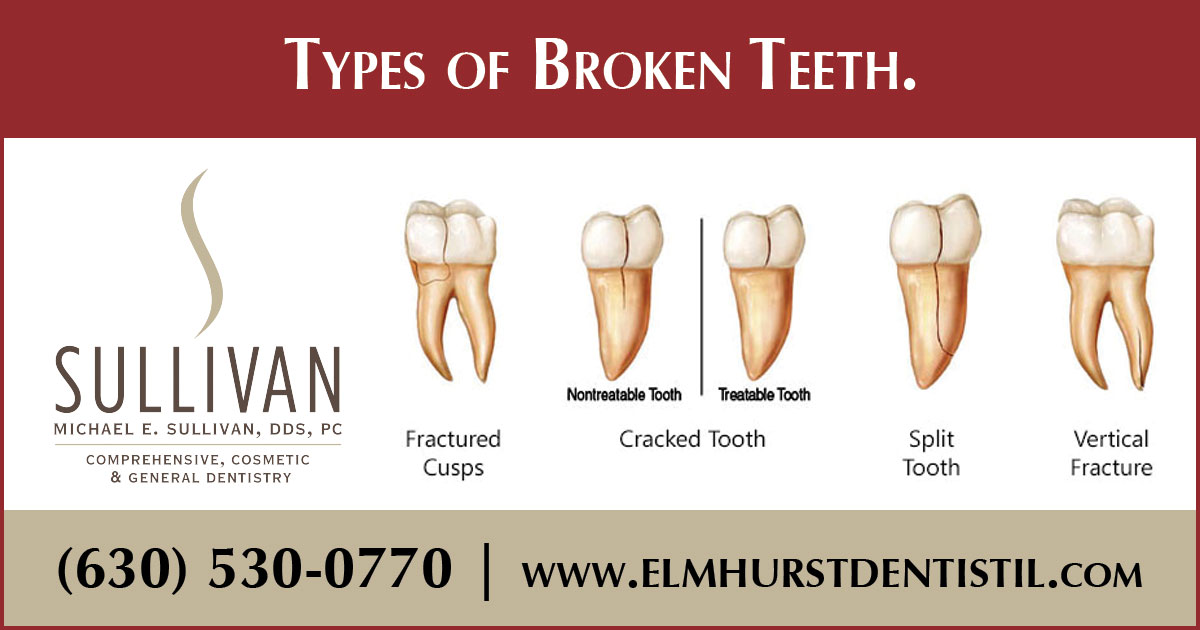Suffering from a cracked or broken tooth?
OUCH! We feel bad for you. That can be very painful. Please get that looked at as soon as possible.
For emergency dental care in Elmhurst, IL CALL 630-530-0770.
What are the different types of broken teeth?
- Minor Cracks
- Cracked Tooth
- Chipped Tooth
- Broken Cusp
- Serious Break
- Split Tooth
- Vertical Break/Split Root
- Decayed Tooth
There are several different types of broken teeth. It’s important to identify the type of fracture correctly because the type of break determines the type of treatment required.
Minor Cracks
Some minor cracks may be called “craze lines,” which are small surface cracks that affect only the outer enamel surface of the tooth.
Some minor cracks do not require treatment. However, your dentist may lightly polish the area to smooth out any rough spots.
Cracked Tooth
This type of fracture involves the whole tooth, from the chewing surface all the way down to the nerve.
The pieces remain in place, but the crack gradually spreads. Cracks can sometimes be repaired with filling material. The tooth often will need a crown to prevent the crack from getting worse.
If the pulp (nerve and other live tissues) is damaged, you may need a root canal as well.
Chipped Tooth
Minor chips don’t always need treatment. Your dentist may suggest repairing the damage with filling material to prevent it from getting worse or to make the tooth look and feel better. If the chip is very small, the dentist may polish and smooth out the chipped area.
Broken Cusp
These breaks affect the pointed chewing surfaces (the cusps) of the teeth. They usually do not affect the pulp and are unlikely to cause much pain.
Your dentist may repair the damage to restore the tooth’s shape. Frequently, however, an onlay or crown will be required.
Serious Break
These breaks go deep enough to expose the nerve. They almost always cause the tooth to hurt and be sensitive. Usually, the broken part of the tooth will bleed.
You will need root canal treatment to remove the exposed nerve and probably a crown to restore the tooth to normal function so you can eat and chew properly.
Split Tooth
This means that the tooth has split vertically into two separate parts.
Some teeth, such as your back teeth (molars), have more than one root. It may be possible to keep one of the roots, which will then be covered with a crown.
First, you will need root canal treatment. Second, the dentist will remove any roots that cannot be kept. Third, you will need a crown to cover the root and replace the tooth. In some cases, when a root cannot be saved, the tooth will have to be removed.
Vertical Break/Split Root
These cracks start in the root of the tooth and extend upward toward the chewing surface.
These breaks are often painful because the area around the root may be inflamed or infected. In most cases, the tooth will have to be removed.
Decayed Tooth
A decay induced crack occurs when a tooth has broken or crumbled because a cavity has weakened it from the inside out.
A dentist will evaluate the cavity and recommend the best way to restore the tooth. In some cases, if the decay is extensive and goes down to the bone, the tooth may have to be removed.
We recommend you visit a dentist as soon as possible so they can help you and work to prevent further issues in the future.
The Office of Michael E. Sullivan can diagnose your cracked or broken tooth and determine the right treatment for your dental health.
For an appointment with Elmhurst dentist Michael E. Sullivan, CALL 630-530-0770.


